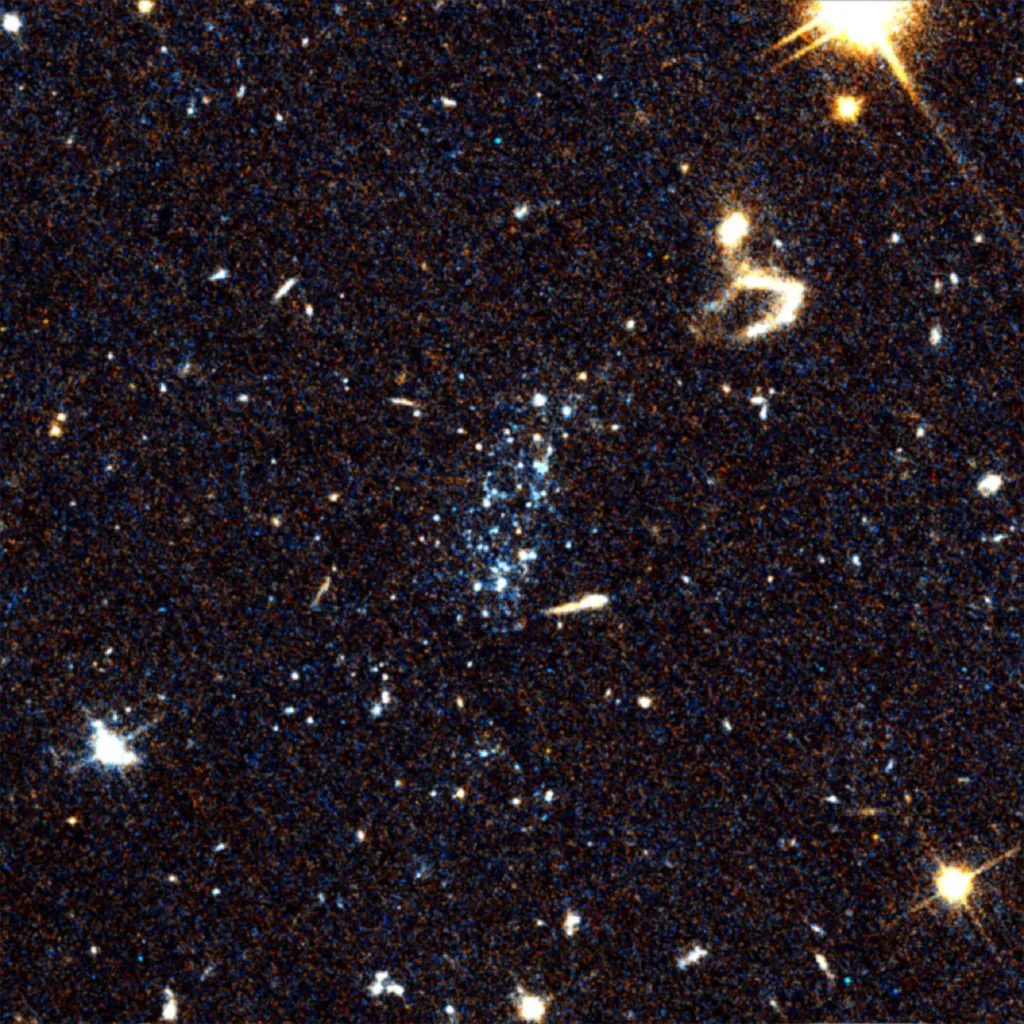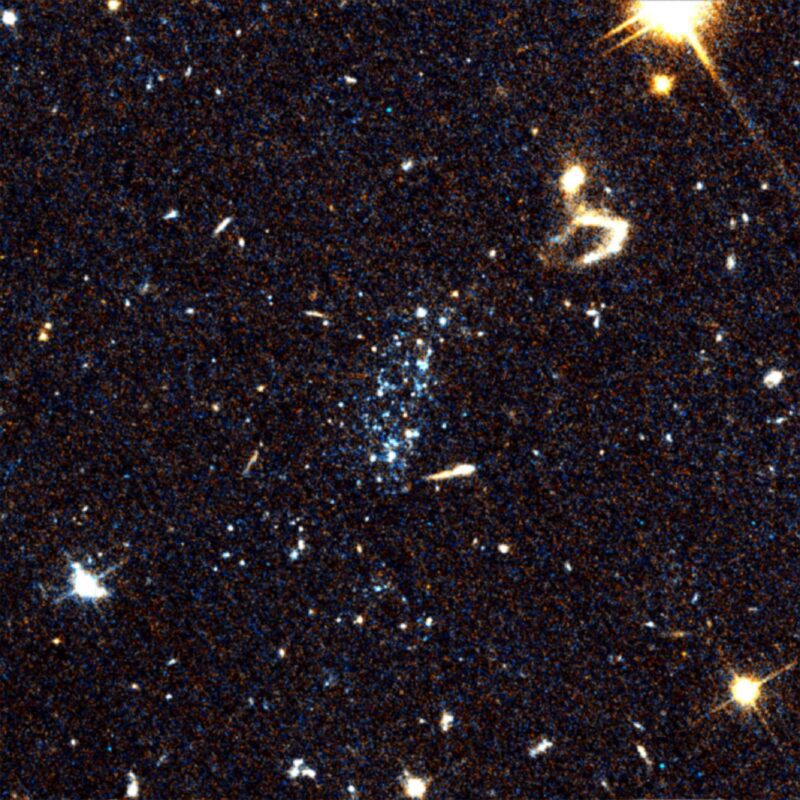
Les astronomes de l’Université d’Arizona ont identifié une nouvelle classe de système stellaire. La collection d’étoiles bleues, pour la plupart jeunes, est observée ici à l’aide de la caméra de surveillance avancée du télescope spatial Hubble. Crédit : Michael Jones
On pense que les structures stellaires sont créées lorsque des galaxies entrent en collision avec des gaz chauds dans un processus qui pourrait être comparé à un saut à plat ventre dans une piscine.
Des astronomes de l’Université d’Arizona ont identifié cinq exemples d’une nouvelle classe de systèmes stellaires. Ils ne sont pas tout à fait des galaxies et n’existent que de manière isolée.
Les nouveaux systèmes stellaires ne contiennent que des étoiles jeunes et bleues, distribuées de manière irrégulière et semblant exister dans un isolement surprenant de toute galaxie mère potentielle.
Les systèmes stellaires – qui, selon les astronomes, apparaissent dans un télescope comme des “taches bleues” et ont la taille de minuscules galaxies naines – sont situés dans l’amas de galaxies Vierge, relativement proche. Les cinq systèmes sont séparés de toute galaxie mère potentielle par plus de 300 000 années-lumière dans certains cas, ce qui rend difficile l’identification de leurs origines.
Les astronomes ont découvert les nouveaux systèmes après qu’un autre groupe de recherche, dirigé par Elizabeth Adams de l’Institut néerlandais de radioastronomie, ait compilé un catalogue de nuages de gaz proches, fournissant une liste de sites potentiels de nouvelles galaxies. Une fois ce catalogue publié, plusieurs groupes de recherche, dont celui dirigé par David Sand, professeur associé d’astronomie à l’Arizona, ont commencé à chercher des étoiles qui pourraient être associées à ces nuages de gaz.
On pensait que les nuages de gaz étaient associés à notre propre galaxie, et la plupart le sont probablement, mais lorsque la première collection d’étoiles, appelée SECCO1, a été découverte, les astronomes ont réalisé qu’elle n’était pas proche de la Milky Way at all, but rather in the Virgo cluster, which is much farther away but still very nearby in the scale of the universe.
SECCO1 was one of the very unusual “blue blobs,” said Michael Jones, a postdoctoral fellow in the UArizona Steward Observatory and lead author of a study that describes the new stellar systems. Jones presented the findings, which Sand co-authored, during the 240th American Astronomical Society meeting in Pasadena, California, Wednesday.
“It’s a lesson in the unexpected,” Jones said. “When you’re looking for things, you’re not necessarily going to find the thing you’re looking for, but you might find something else very interesting.”
The team obtained their observations from the Hubble Space Telescope, the Very Large Array telescope in New Mexico and the Very Large Telescope in Chile. Study co-author Michele Bellazzini, with the Istituto Nazionale di Astrofisica in Italy, led the analysis of the data from Very Large Telescope and has submitted a companion paper focusing on that data.
“When a galaxy belly flops into a cluster that is full of hot gas, then its gas gets forced out behind it. That’s the mechanism that we think we’re seeing here to create these objects.”
Together, the team learned that most of the stars in each system are very blue and very young and that they contain very little atomic hydrogen gas. This is significant because star formation begins with atomic hydrogen gas, which eventually evolves into dense clouds of molecular hydrogen gas before forming into stars.
“We observed that most of the systems lack atomic gas, but that doesn’t mean there isn’t molecular gas,” Jones said. “In fact, there must be some molecular gas because they are still forming stars. The existence of mostly young stars and little gas signals that these systems must have lost their gas recently.”
The combination of blue stars and lack of gas was unexpected, as was a lack of older stars in the systems. Most galaxies have older stars, which astronomers refer to as being “red and dead.”
“Stars that are born red are lower mass and therefore live longer than blue stars, which burn fast and die young, so old red stars are usually the last ones left living,” Jones said. “And they’re dead because they don’t have any more gas with which to form new stars. These blue stars are like an oasis in the desert, basically.”
The fact that the new stellar systems are abundant in metals hints at how they might have formed.
“To astronomers, metals are any element heavier than helium,” Jones said. “This tells us that these stellar systems formed from gas that was stripped from a big galaxy, because how metals are built up is by many repeated episodes of star formation, and you only really get that in a big galaxy.”
There are two main ways gas can be stripped from a galaxy. The first is tidal stripping, which occurs when two big galaxies pass by each other and gravitationally tear away gas and stars.
The other is what’s known as ram pressure stripping.
“This is like if you belly flop into a swimming pool,” Jones said. “When a galaxy belly flops into a cluster that is full of hot gas, then its gas gets forced out behind it. That’s the mechanism that we think we’re seeing here to create these objects.”
The team prefers the ram pressure stripping explanation because in order for the blue blobs to have become as isolated as they are, they must have been moving very quickly, and the speed of tidal stripping is low compared to ram pressure stripping.
Astronomers expect that one day these systems will eventually split off into individual clusters of stars and spread out across the larger galaxy cluster.
What researchers have learned feeds into the larger “story of recycling of gas and stars in the universe,” Sand said. “We think that this belly-flopping process changes a lot of spiral galaxies into elliptical galaxies on some level, so learning more about the general process teaches us more about galaxy formation.”
Reference: “Young, blue, and isolated stellar systems in the Virgo Cluster. II. A new class of stellar system” by Michael G. Jones, David J. Sand, Michele Bellazzini, Kristine Spekkens, Ananthan Karunakaran, Elizabeth A. K. Adams, Giuseppina Battaglia, Giacomo Beccari, Paul Bennet, John M. Cannon, Giovanni Cresci, Denija Crnojevic, Nelson Caldwell, Jackson Fuson, Puragra Guhathakurta, Martha P. Haynes, John L. Inoue, Laura Magrini, Ricardo R. Munoz, Burcin Mutlu-Pakdil, Anil Seth, Jay Strader, Elisa Toloba and Dennis Zaritsky, 3 May 2022, Astrophysics > Astrophysics of Galaxies.
arXiv:2205.01695



